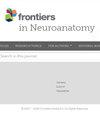Understanding subcortical projections to the lateral posterior thalamic nucleus and its subregions using retrograde neural tracing
IF 2.3
4区 医学
Q1 ANATOMY & MORPHOLOGY
引用次数: 0
Abstract
The rat lateral posterior thalamic nucleus (LP) is composed of the rostromedial (LPrm), lateral (LPl), and caudomedial parts, with LPrm and LPl being areas involved in information processing within the visual cortex. Nevertheless, the specific differences in the subcortical projections to the LPrm and LPl remain elusive. In this study, we aimed to reveal the subcortical regions that project axon fibers to the LPl and LPrm using a retrograde neural tracer, Fluorogold (FG). After FG injection into the LPrm or LPl, the area was visualized immunohistochemically. Retrogradely labeled neurons from the LPrm were distributed in the retina and the region from the diencephalon to the medulla oblongata. Diencephalic labeling was found in the reticular thalamic nucleus (Rt), zona incerta (ZI), ventral lateral geniculate nucleus (LGv), intergeniculate leaflet (IGL), and hypothalamus. In the midbrain, prominent labeling was found in the periaqueductal gray (PAG) and deep layers of the superior colliculus. Additionally, retrograde labeling was observed in the cerebellar and trigeminal nuclei. When injected into the LPl, several cell bodies were labeled in the visual-related regions, including the retina, LGv, IGL, and olivary pretectal nucleus (OPT), as well as in the Rt and anterior pretectal nucleus (APT). Less labeling was found in the cerebellum and medulla oblongata. When the number of retrogradely labeled neurons from the LPrm or LPl was compared as a percentage of total subcortical labeling, a larger percentage of subcortical inputs to the LPl included projections from the APT, OPT, and Rt, whereas a large proportion of subcortical inputs to the LPrm originated from the ZI, reticular formation, and PAG. These results suggest that LPrm not only has visual but also multiple sensory-and motor-related functions, whereas the LPl takes part in a more visual-specific role. This study enhances our understanding of subcortical neural circuits in the thalamus and may contribute to our exploration of the mechanisms and disorders related to sensory perception and sensory-motor integration.利用逆行神经追踪了解丘脑外侧后核及其亚区的皮层下投射
大鼠丘脑外侧后核(LP)由喙内侧(LPrm)、外侧(LPl)和尾内侧部分组成,其中LPrm和LPl是视觉皮层内参与信息处理的区域。然而,皮层下投射到LPrm和LPl的具体差异仍然难以捉摸。本研究旨在利用逆行神经示踪剂荧光金(FG)揭示向LPl和LPrm投射轴突纤维的皮层下区域。将 FG 注入 LPrm 或 LPl 后,对该区域进行免疫组化观察。LPrm逆行标记的神经元分布在视网膜和从间脑到延髓的区域。在网状丘脑核(Rt)、内侧带(ZI)、腹外侧膝状核(LGv)、膝间小叶(IGL)和下丘脑中发现了间脑标记。在中脑,上丘周围灰质(PAG)和上丘深层发现了显著的标记。此外,在小脑和三叉神经核也观察到逆行标记。当注射到 LPl 时,在视觉相关区域,包括视网膜、LGv、IGL 和橄榄直视前核(OPT),以及 Rt 和直视前核(APT),一些细胞体被标记。小脑和延髓的标记较少。当比较来自 LPrm 或 LPl 的逆行标记神经元数量占皮层下标记总数的百分比时,皮层下输入 LPl 的较大百分比包括来自 APT、OPT 和 Rt 的投射,而皮层下输入 LPrm 的较大百分比源自 ZI、网状结构和 PAG。这些结果表明,LPrm不仅具有视觉功能,还具有多种感觉和运动相关功能,而LPl则更多地发挥视觉特异性作用。这项研究加深了我们对丘脑皮层下神经回路的了解,可能有助于我们探索与感觉知觉和感觉运动整合相关的机制和疾病。
本文章由计算机程序翻译,如有差异,请以英文原文为准。
求助全文
约1分钟内获得全文
求助全文
来源期刊

Frontiers in Neuroanatomy
ANATOMY & MORPHOLOGY-NEUROSCIENCES
CiteScore
4.70
自引率
3.40%
发文量
122
审稿时长
>12 weeks
期刊介绍:
Frontiers in Neuroanatomy publishes rigorously peer-reviewed research revealing important aspects of the anatomical organization of all nervous systems across all species. Specialty Chief Editor Javier DeFelipe at the Cajal Institute (CSIC) is supported by an outstanding Editorial Board of international experts. This multidisciplinary open-access journal is at the forefront of disseminating and communicating scientific knowledge and impactful discoveries to researchers, academics, clinicians and the public worldwide.
 求助内容:
求助内容: 应助结果提醒方式:
应助结果提醒方式:


